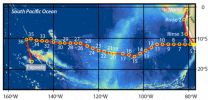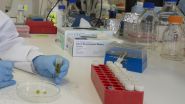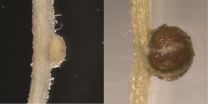A new study by researchers from University of Washington (UW), Old Dominion University (ODU), Woods Hole Oceanographic Institution (WHOI), the University of Southern California and Liverpool University in the UK, demonstrates that chemical-laden plumes erupted from vents at one section of Mid Ocean Ridge in the SE Pacific can be traced all the way across the Pacific for more than 4000 kilometers. Further, the study shows how the iron transported by this process can be brought to the surface oceans of Antarctica where it has the potential to serve as a key life-sustaining micro-nutrient, supporting extensive fixation and removal of organic carbon from the sunlit upper waters of that ocean.
"This proves that hydrothermal activity at the mid-ocean ridges impacts the global ocean chemistry of important trace metals," said lead author Joseph Resing, a senior research scientist at the UW's Joint Institute for the Study of the Atmosphere and Ocean, a partnership with the National Oceanic and Atmospheric Administration. "On longer timescales, it also impacts the productivity of the oceans."
The study was published yesterday in Nature and is featured on the journal's cover. The research was funded by the National Science Foundation as part of the US contribution to GEOTRACES, a large international chemical oceanography program.
"The last major international chemical oceanography program was conducted in the 1970s, before the discovery of hydrothermal vents," said WHOI marine geochemist Chris German, who was co-chief for the expedition. "We have long suspected vents could supply significant micronutrients to the ocean, but the GEOTRACES program really allowed us to test our theories."
The data for the study were collected during a two-month expedition in late 2013 in the Pacific Ocean. German and his co-chief scientist, Jim Moffett of USC, had selected the research site, in part, because of German's long-standing interest in studying the impact of a massive hydrothermal plume, first discovered in the 1980s by John Lupton and Harmon Craig, that stretched across a large section of the Pacific. Lupton and Craig tracked the plume using helium-3, an unreactive gas that comes into the ocean primarily from hydrothermal and volcanic discharge on the seafloor. Because helium-3 is unreactive, it can be used as a purely physical tracer for the dispersal of the plume once it's released into the ocean as it is blown "down-wind" by deep ocean currents.
"Rather than following a constant depth in the ocean, that plume actually follows along a constant density surface," said German, "And what you find is that the plume water that's at around 2000 meters depth in the central tropical Pacific, if you follow it along its level of constant density, will actually curve upward toward the surface in the Antarctic."
German was eager to study the chemical impact of plume because, in theory, if the plume were carrying micronutrients, it could have large implications for the global biogeochemical cycle.
Much of German's recent research has been focused on the fate of iron around hydrothermal vent sites, "because we know it's the most abundant of the trace metals coming out of hydrothermal vents," he said "and also because it is an essential micro-nutrient that is known to be in short supply elsewhere in the oceans".
In fact, it is the iron in the hydrothermal vent fluid that is responsible for most of the "black smoke" emanating from the vents and until very recently it was widely held that all that dissolved iron precipitates out of the vent fluid and rains down to the seafloor close to vent sites to generate massive sulfide deposits and metal-rich sediments.
"For about 15 years, I was confident that there was no important release of dissolved iron from hydrothermal vents into the wider ocean," said German. "I thought the iron all dropped out onto the seafloor, near the ridge axis."
But in the early 2000s, German and one of his graduate students started making measurements of ratios of different isotopes of iron. It turned out that hydrothermal iron has a signature you can actually fingerprint and compare to the rest of the iron in the ocean. Working on a sample of manganese crusts from a seamount in the middle of the Pacific, they found that about half of all the iron that was precipitating out there, miles away from any ridge crest, should have been hydrothermally sourced.
"That seemed like a crazy result," German said. "We thought, 'That can't be right because there's no way that half of all the iron out in the middle of the ocean could be sourced from hydrothermal vents.'"
They ran some back of the envelope calculations to see what it would take for this to be true and it turned out that because dissolved iron is so low in the open ocean and it's so high in hydrothermal vents, both things actually could be true. "You could have almost all of the iron precipitate out near a ridge axis where the venting occurs, but if anywhere between 0.5 and 2 percent of the iron stayed in solution, that could actually represent half of all the dissolved iron out in the world's oceans.
Much of the iron entering the ocean is derived from wind-blown dust from land masses. However, the only way to close the budget for iron in the world's oceans, based on the first few sets of data collected anywhere in the world's oceans as part of the GEOTRACES program, proved to require, apparently, that there was such a hydrothermal input.
Based on that research German and his colleagues concluded that there should be a very good chance that they would measure iron some distance across this section of the Pacific. In practice, what the researchers observed allows them to estimate that hydrothermal systems contribute four times more dissolved iron to the global ocean than had ever previously been estimated and, further, that this iron sustains a significant fraction of the Southern Ocean's ability to drive primary biological productivity in the surface ocean and, as result, transfer carbon dioxide from the atmosphere into deep.
"For me, this study's result is extremely gratifying," said German. "It's allowed us to test ideas resulting from a body of work that I've been pursuing over the past decade. The GEOTRACES program has now allowed us to go test the hypotheses arising from that work, and the results have been quite spectacular: even with what we thought were our most outrageous predictions, it turns out that we had always underestimated what we have now shown the true impact to be."
The study's finding is especially important for the Southern Ocean, circling Antarctica, where massive phytoplankton blooms are known to be limited by iron supplies, and where winds are less likely to carry iron-rich dust. Biological productivity in the Southern Ocean and the associated draw-down of CO2 from the overlying atmosphere might be quite different if it were not for the transport of iron emanating from hydrothermal vent sites in the depths of the tropical South Pacific. Such "teleconnections", as revealed by this study, only help to emphasize both the interconnectedness of the oceans as a whole and, further, how important the pursuit of an ever better understanding of natural biogeochemical cycles in the ocean is to predicting and modeling the ocean-climate system.
INFORMATION:
The Woods Hole Oceanographic Institution is a private, non-profit organization on Cape Cod, Mass., dedicated to marine research, engineering, and higher education. Established in 1930 on a recommendation from the National Academy of Sciences, its primary mission is to understand the ocean and its interaction with the Earth as a whole, and to communicate a basic understanding of the ocean's role in the changing global environment. For more information, please visit http://www.whoi.edu.




